|

by Dan Eden
from
ViewZone Website
Spanish version
|
Note
Since this article was
first published, viewzone has received more information
on "doomsday," including visual and scientific evidence
that a solar "extinction event" happened in the past. |
Part 1
December 21, 2012
ViewZone asked me to write a story about the Mayan Calendar.
There is a common belief that the
calendar holds a prophecy that the world will end in 2012. I knew
very little about the whole topic when I began doing the research. I
like to think I had an open mind. My investigation began with
mainstream archaeology and expert interpretations of the calendar.
But it soon took a turn that made my hair literally stand on end. I
am now convinced that these prophecies are true.
To understand what is likely to happen to Earth and its people, you
will need to remain calm and try to follow the facts. It's not as
simple as some people describe.
It requires an understanding of some
fairly complicated science, but I think I can explain this in a way
that you will easily understand.
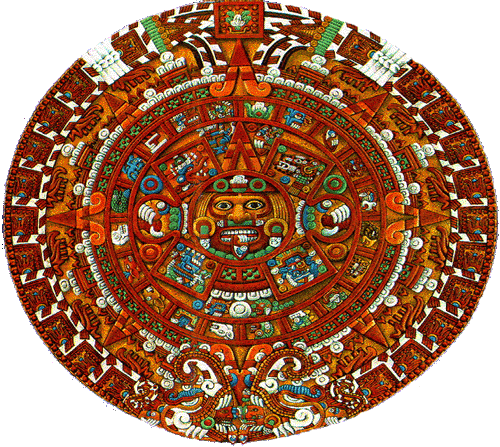
The Calendar -
A Description
First, the
Mayan calendar is also sometimes called the
Aztec
Calendar. This calendar is recorded as a carving on the Aztec "sun
stone," currently on exhibit in the National Museum of Anthropology
and History located within Chapultepec Park, Mexico City. There's a
lot we could say about this carved stone but most of those details
are irrelevant to the "end times."
Our modern calendar, called the Gregorian Calendar, has days, weeks,
months and years. In the Mayan Calendar it's more complex. In fact,
it's really three calendars at the same time.
First there's a religious calendar that takes 260 days to complete a
full religious cycle. There are 20 "weeks" made up of 13 days. Each
week has a special name, a graphic logo and unique meaning
associated with it.
This reminds me of the Chinese years
which cycle through "the year of the rat" and "the year of the
monkey," etc., each with it's special image and meaning.

Graphic logos for
each of the 20 religious weeks.
Next there is the solar calendar. This
has 365 days, like our modern calendar.
It's divided in 18 months of 20 days
each. At the end of the cycle there's five special days considered
to be unlucky because they don't belong to any month. Each of the
months has a special name, graphic logo and some special
significance, similar to the icons for the weeks in the religious
calendar.
So it is possible, for any specific date, the calculate the
religious week and the solar month and to predict the influences
that might be guiding fate. But that's not really what's involved
with the prophecy of 2012. To understand that we must look at the
third calendar, called the long count.
While the first two cycles could be thought of as cogs or gears (see
below) revolving through time, the long count is a linear number of
days, starting from the first day, "1," and counting through each
day to the present. Any day in history can be recorded using the
long count and, with some simple mathematics, the corresponding
religious week and solar month can also be found.
In writing this article, I thought about creating a javascript
program that would do this calculation. My friend, Gene Matlock,
then told me that when he was in Mexico, he found a place that sold
wooden, mechanical calculators with gears that did just that. He
said that Mexicans sometimes used these mechanical calendars to
foretell the future or to find auspicious times for special events
like marriage or births.
Anyway, although it might be nice to
know the religious and solar significance, it's the long count that
foretells Doomsday.

Cog or "gears" can be
used to compute the religious and solar cycles for any date.
The days of the long count are numbered
with an unusual system. Instead of writing numbers as we do, from
right to left with each place being a multiple of 10 (i.e. 10000,
1000, 100, 10, 1), the Mayans had only 5 places.
The first place recorded a number from 0 to 20. To the left, the
second place could have a range from 0 to 17; the third from 0 to
19; the fourth from 0 to 19 and the last from 0 to 12. The numbers
were written from right to left, like our system, separated by a
dot. Instead of multiples of 10, the first place had a multiple of 1
(like our system); the second place a multiple of 20; the third a
multiple of 360; the fourth a multiple of 7200 and the fifth a
multiple of 144000.
So a long count number, for example, could be written as 4.12.5.9.0
and would be calculated as follows:
(4 x 144000) + (12 x 7200) + (5 x
360) + (9 x 20) + (0 x 1) or a long count of 664,380.
It's not too difficult to realize that
the maximum number which can be recorded this way would be
12.19.19.17.20, although some researchers like to write it as
13.0.0.0.0. This amounts to a long count number of 1,872,000 days or
5125.36 years of our modern calculations. Obviously, the calendar is
very old!
Over the years, archaeologists have found carved monuments that
recorded the long count for known dates in Mayan history. Once a
date was fixed in time, it was easy to determine "day 1" as August
11th, 3114 BC. And it was also easy to calculate the date at which
the calendar would end - December 21st, 2012.
Trust me, just because the calendar ends doesn't prove that time, or
the world, or life will end. We need to look carefully at December
21, 2012 and try to understand why the Mayans never calculated a
date beyond this point in time.
To do this we must move from Archaeology
to the science of Astronomy and Astrophysics.
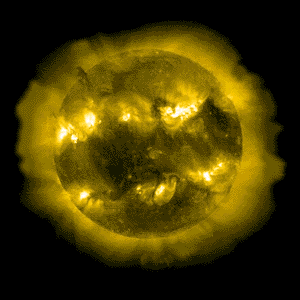 It's
all about the Sun It's
all about the Sun
It's ironic (or maybe not) that the Mayan Calendar is often called
the "sun stone."
While the calendar does have "solar"
days, acknowledging the 365 days it takes for Earth to rotate around
the Sun, it is also true that
the Sun plays a key role in the final
day of the "long count." To understand what will happen to the Sun
on December 21, 2012, we need to review some scientific terms like
"ecliptic," "barycenter," and "sunspots."
These are important in the discussion
that follows.
We'll start with the most difficult one
first.
Terms we will encounter...
What is the Barycenter?
You've no doubt heard
that Earth revolves around the sun. Well, actually, that's not
quite true!
Have you heard the term "center of gravity"? It's a
technical-sounding term for something pretty simple. It's the
exact center of all the material (that is, mass) that makes up
the object. For example, if you have a straight stick, like a
ruler or yardstick, there's a place at the middle where you can
balance it on your finger.
That's its center of gravity.

But the center of gravity may or may
not be the point that is exactly in the middle, distance-wise,
of the object.
Some parts of the object may be
heavier (denser) than others. If you have something like a
sledge hammer that is heavier on one end than the other, the
center of gravity will be much closer to the heavy end than the
lighter end.

To get an idea of where the center
of gravity is, rest the ends of any object like the ruler or a
pencil on one finger from each hand.
Slowly move your fingers together
without dropping the object. Your fingers will meet underneath
the object's center of gravity. You can balance the object on
one finger at that special place.
The actual center of gravity could be close to the surface or
deep inside, depending on whether the object is flat like a
ruler or a dinner plate, or "three-dimensional," like a box or a
ball. And if you let the object spin (like when you throw it),
it will try to spin about that point.
In the case of the Earth and the sun, both bodies actually
revolve, or spin, around the very center of the mass (similar to
center of gravity) between them. This point is called the "barycenter."
Earth and the sun are "connected" by the gravity pulling them
together. It's just like the light end and heavy end of the
sledge hammer. Compared to the size of the sun, Earth is about
like a flea on a cat! So the center of mass between the Earth
and the sun is almost - but not quite - the very center of the
sun.
In the case of a planet the size of Jupiter, which is 318 times
as massive as Earth, the barycenter of Jupiter and the sun is a
bit further from the sun's center.
So, as Jupiter revolves around the
sun, the sun itself is actually revolving around this slightly
off-center point, located just outside its center. Thus, a
planet the size of Jupiter will make the sun (or any star)
appear to wobble a tiny bit. This picture shows you that the
center of mass and barycenter can be slightly different points.
It isn't meant to be very accurate!

We can take advantage of this bit of knowledge and look for
large planets in other solar systems by learning to detect this
type of tiny wobble in the star's position.
For now, let's forget all the small
planets and focus on Jupiter. It makes one complete trip around the
Sun every 11.861773 years.
There's a new theory put forth by Dr.
Rollin Gillespie which shows that Jupiter, and to a smaller degree
the other less massive planets, may trigger the 11 year cycle of
sunspots and solar flares.
Here's how it
works
The barycenter is not a single point in the Sun.
Because the Sun is a rotating gaseous
sphere, the barycenter forms a vertical, cylindrical "sleeve" that
is partially inside and outside the main solar body. All of the
planets have such a "sleeve," one inside the other, depending on
their relative mass and the location of their barycenters. The
particular sleeve representing the mass of Jupiter intersects the
solar surface at 35.9 degrees North and South.
This is precisely where sunspot and
flare activity begin and end during each 11 year cycle.
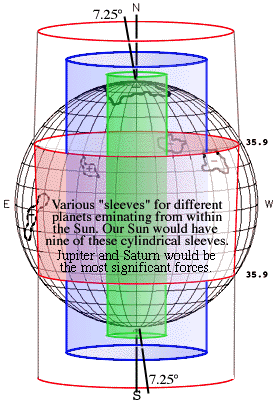
The new cycle has already begun with the
recent observation of a solar spot with reverse polarity.
But some surprising activity on March
27, 2008, showed some huge eruptions with M-class radiation at about
the equatorial region of the Sun [see
Solar Map]. These surprising
eruptions suggests a barycenter of disturbance from an object even
more massive than Jupiter, placing the "sleeve" outside the Sun.
Could this be the beginning of the Galaxy's effects on our Sun?
Scientists have noted that when Jupiter and Saturn are aligned on
the same side of the Sun, the solar maximum (the period when we have
the most sunspots and flares) is at its weakest; when they are on
opposite sides of the Sun the solar maximum is at its strongest.
The positions of these two planets on
December 21, 2012 are ideal for extreme solar activity.
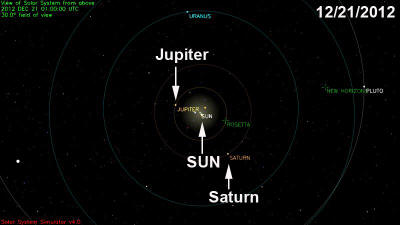
Above: Position of
Jupiter and Saturn on 12/21/2012.
These cylinders are usually quite
orderly because the planets adhere to a narrow plane, called the
ecliptic which resembles a thin plate extending from the equator of
the Sun.
The planets hang out here because (in
simple terms) this is the zone where the gravitation of the system
is the strongest. (see below)
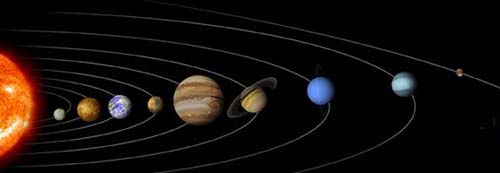
The planets orbit the
Sun in a narrow plane called the ecliptic.
But nature is never perfect.
The Sun rotates at a slight angle (7.25
degrees), much as our Earth does.
As it wobbles, it tilts the sleeves,
causing them to clash with each other and eventually disrupt the
surface. Having the barycenters of the to most massive planets,
Jupiter and Saturn, in maximum misalignment is especially
disruptive. This disturbance, to put it simply, works its way to the
surface and erupts in sun spots and solar flares or CME's
(Coronal Mass Ejections).
The last solar cycle was at its maximum in 2001. Each active solar
cycle has a period when the flares are strongest, usually happening
near the solar equator, called the "solar maximum." This is
significant because the next "solar maximum" event will coincide
with December 21, 2012. But wait - there's much more!
Solar flares are pieces of the sun which leap into space,
discharging radiation and strong electrical currents that travel
outward into space. They often fall back to the surface of the Sun.
Sometimes, a very strong flare, called a Coronal Mass Ejection
(CME), actually leaves the Sun and this deadly mass shoots out from
the Sun towards the planets like a bullet.
Usually these CME's don't hit anything
but occasionally they hit a planet like Earth.
Some believe a powerful CME once hit
Mars.
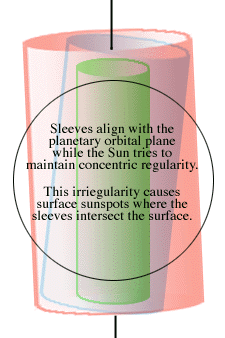
Most solar flares are small. But even a
small flare can be dangerous.
In 1989 a flare hit the North American
continent and fried electric lines, zapped power grids in the US and
Canada, and created large power blackouts. Flares can also effect
our moods and physical health. In theory, a large flare impacting
the Earth could zap the ionosphere (there goes all the satellites,
cell-phones, GPS...) and irradiate the surface, killing every living
organism that it touched.
Solar flares and sun spots have an average cycle of 11.120412 years
(estimated from one "solar maximum" to the next). Right now, 2009,
we are just entering the active period of cycle number 24, after an
unusually long period of quiet solar activity. This quiet period led
some people at NASA to conclude that cycle 24 would be a very quiet
cycle - contradicting the earlier predictions they made for an
extremely violent cycle.
Now they have redacted their call for a
quiet cycle since the activity has again commenced. The scientists
who study the Sun have also recently announced that they have
measured the solar currents, deep inside the Sun, which correspond
the Dr. Gillespie's barycenter currents. But to date they have not
been able to agree what causes these deep currents of solar
material.
The small discrepancy between the average 11.120412 year solar cycle
and the 11.861773 year period of Jupiter is close enough to be
significant but suggests that something else is also influencing
solar disturbances.
Sure, it could be attributed to the
various positions of the other less massive planets, but it could
also be something even more significant - the Milky Way.
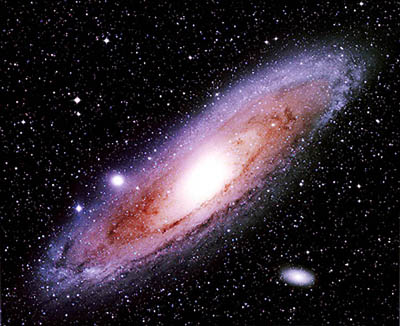
The Galactic
Alignment of December 21, 2012
The Perfect Storm
Our solar system is part of a huge disc shaped collection of stars
and planets called the Milky Way.
We're located somewhere on the edge of
the disc, slightly on top of the narrow disc. But very soon we'll be
moving to the bottom of the disc. This change, from top to bottom,
begins on December 21, 2012.
Yes, that's right. On the same day when our Sun is at it's solar
maximum, something will happen that's never happened for thousands
of eons of time - the ecliptic of our solar system will intersect
with the Galactic plane, called the "Galactic Equator" of the Milky
Way! [see
star chart].
If you imagine our solar system as a bunch of peas on a plate, with
a huge meatball in the center, imagine the Milky Way as a city-size
pizza with the "Guiness World Book Record Meatball" in its center!
Prior to December 2012 we have been drifting on the top of the
pizza, never really able to see the bottom. The plate and pizza are
not parallel. They are moving at different angles. We've been
drifting down, down, down... and on December 21st, 2012, we will be
exactly level with the crust - forming an "x" at the Galactic
Equator where galactic gravity is the strongest.
After 2012, if we
are still here, we will be passing through the bottom zone, viewing
the Milky Way pizza from the South.
Yes, there's even more!
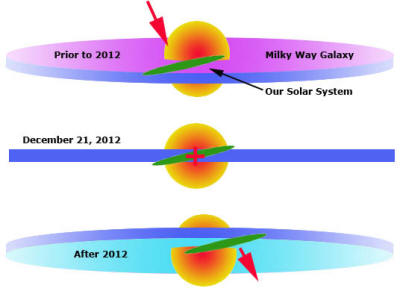
By some amazing coincidence, not only
will we be intersecting with the Galactic Equator, but we will be
doing this precisely aligned with the center of the Galaxy where
there is maximum mass!
More mass means more gravity. More
gravity means more influence from those barycenters in our Sun. That
means exponential increases in solar disruptions - all coinciding on
the same day!
Whew!
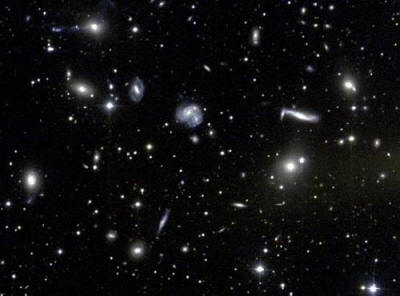
Above:
The Hercules Cluster
of galaxies.
This group of
galaxies is held together by the gravitational attraction or "pull"
of each individual galaxy on the others in the group.
This demonstrates the
enormous gravity contained in a galaxy, such as our own Milky Way.
An apology and
acknowledgement
This has been a "light weight"
description of what's going to happen. It has been simplified to
the point where some scholars and scientists could argue about
my presentation. But the main facts are true.
The date,
December 21, 2012, is a
special day. It represents the maximum possible influences for
solar flares that the universe can provide. Undoubtedly the
Mayans, or the civilization that influenced them, somehow knew
about these things.
Over the last decade, I have written a variety of stories about
such things as underground cities and government actions that
could only make sense if there were no future. I cannot help but
think that maybe they, like the Mayans, know about these things.
I'd specifically like to suggest that readers take another look
at the
underground complex at Yamantau
that the Russians are building.
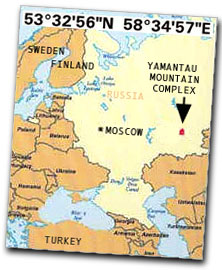 Could
this be a haven for surviving a solar blast? Could
this be a haven for surviving a solar blast?
And the "doomsday seed bank" that's
being filled deep inside an Arctic island.
-
And what about past events?
-
Did
the Hopi go underground
to survive a similar event thousands of years earlier?
-
Should we be going
underground also?
It's also important to stress that
December 21, 2012 is only the "solar maximum" but that the
gravitational effects of the Galaxy have already started to
assert their influence on the Sun.
The drift towards alignment with the
galactic equator is relatively slow and, in truth, has already
started. But the precise culmination of this, plus the alignment
of Jupiter and Saturn all make 12/21/12 an ominous date.
I especially want to thank Dr. Rollin Gillespie, a man with whom
I corresponded for ten years and who first developed the idea
that planetary multi-body systems could be at play in the
causation of solar flares.
I would also direct your attention
to the following two news reports of the discovery of gamma rays
coinciding with the Galactic equator (through which we will be
shortly passing) and the alarming report that our planet's
magnetic shield (guarding against, among other things, gamma
radiation) has been damaged. You may want to continue reading the
second part of this article for more details on what to expect.
Please let's have your input on this important issue. It's only
three years away. Who knows, perhaps the influences of these
disruptions will begin well before the solar and Galactic
maximum is reached. We may not have that much time left.
Here are some additional links to
stories that may help understand the possibilities facing our
planet and us.
Comments
Physicists Find Evidence For
Highest Energy Photons Ever Detected From Milky Way's Equator
(ScienceDaily)
Physicists at nearly a dozen
research institutions, including New York University, have
discovered evidence for very high energy gamma rays emitting
from the Milky Way, marking the highest energies ever detected
from the galactic equator. Their findings, published in the Dec.
16 issue of the Physical Review of Letters, were obtained using
the
Milagro Gamma Ray Observatory, a new detector located near
Los Alamos, N.M., that allows monitoring of the northern sky on
a 24-hour, 7-day-per-week basis.
Gamma rays are considered by scientists to be the best probe of
cosmic rays outside the solar neighborhood.
The research team, which includes nearly 40 physicists, reported
that Milagro, positioned at an altitude of 8600 feet in the
Jemez Mountains, detected
a signal along the galactic equator
region and interpreted it as arising from gamma rays with a
median energy of 3.5 trillion electron-volts, or 3500 times the
mass-energy of a proton. Previous satellite experiments have
seen gamma-ray emissions along the galactic equator reaching up
to energies of only 30 billion electron-volts.
These emissions are understood to be produced by interactions of
cosmic-ray particles with the abundant interstellar medium near
the galactic equator. Previously, some researchers had
speculated that additional mechanisms were needed to explain the
large number of particles observed at high energies.
However, the measurements by Milagro
can be understood by assuming a cosmic ray energy spectrum near
the galactic center similar to that in the solar system and the
standard properties of particle interactions.
The results presented in the Physical Review of Letters paper
were gathered over a three-year period, beginning in July 2000.
IMPORTANT UPDATE
January 2009
Scientists have found two
large leaks in Earth's magnetosphere, the region around our
planet that shields us from severe solar storms.
The leaks are defying many of scientists' previous ideas on how
the interaction between Earth's magnetosphere and solar wind
occurs: The leaks are in an unexpected location, let in solar
particles in faster than expected and the whole interaction
works in a manner that is completely the opposite of what
scientists had thought.
The findings have implications for how solar storms affect the
our planet. Serious storms, which involved charged particles
spewing from the sun, can disable satellites and even disrupt
power grids on Earth.
The bottom line: When the next peak of solar activity comes, in
about 4 years, electrical systems on Earth and satellites in
space may be more vulnerable.
How it works
Earth's magnetic field
carves out a cavity in the sun's onrushing field. The Earth's
magnetosphere is thus "buffeted like a wind sock in gale force
winds, fluttering back and forth in the" solar wind, Sibeck
explained.
Both the sun's magnetic field and the Earth's magnetic field can
be oriented northward or southward (Earth's magnetic field is
often described as a giant bar magnet in space).
The sun's magnetic field shifts its orientation frequently,
sometimes becoming aligned with the Earth, sometime becoming
anti-aligned.
Scientists had thought that more solar particles entered Earth's
magnetosphere when the sun's field was oriented southward
(anti-aligned to the Earth's), but the opposite turned out to be
the case, the new research shows.
The work was sponsored by NASA and the National Science
Foundation and based on observations by NASA's
THEMIS (Time
History of Events and Macro-scale Interactions during
Sub-storms) satellite.
How many and where
Essentially, the Earth's
magnetic shield is at its strongest when scientists had thought
it would be at its weakest.
When the fields aren't aligned,
"the shield is up and very few
particles come in," said physicist Jimmy Raeder of the
University of New Hampshire in Durham.
Conversely, when the fields are aligned, it creates "a huge
breach, and there's lots and lots of particles coming in,"
Raeder added, at the news conference.
As it orbited Earth, THEMIS's five spacecraft were able to
estimate the thickness of the band of solar particles coming
when the fields were aligned - it turned out to be about 20
times the number that got in when the fields were anti-aligned.
THEMIS was able to make these measurements as it moved through
the band, with two spacecraft on different borders of the band;
the band turned out to be one Earth radius thick, or about 4,000
miles (6,437 kilometers).
Measurements of the thickness taken later showed that the band
was also rapidly growing.
"So this really changes our
understanding of solar wind-magnetosphere coupling," said
physicist Marit Oieroset of the University of
California, Berkeley, also at the press conference.
And while the interaction of
anti-aligned particles occurs at Earth's equator, those of
aligned particles occur at higher latitudes both north and south
of the equator.
The interaction is "appending blobs of plasma onto the Earth's
magnetic field," which is an easy way to get the solar particles
in, said Sibeck, a THEMIS project scientist.
Next solar cycle
This finding not only has
implications for scientists' understanding of the interaction
between the sun and Earth's magnetosphere, but for predicting
the effects to Earth during
the next peak in the solar cycle.
The Sun operates on an 11-year cycle, alternating between active
and quiet periods. We are currently in a quiet period, with few
sunspots on the sun's surface and fewer solar flares, though the
next cycle of activity has begun.
It is expected to peak around 2012, bringing lots of sunspots,
flares and coronal mass ejections (CMEs). CMEs can interact with
the Earth's magnetosphere, causing problems for satellites,
communications, and power grids.
This upcoming active period now looks like it will be more
intense than the previous one, which peaked around 2006, some
scientists think. The reason is the changes in the sun's
alignment.
During the last peak, solar fields hitting the Earth were first
anti-aligned then aligned. Anti-aligned fields can energize
particles, but in this case, the energy came before the
particles themselves, which doesn't create much of a fuss in
terms of geomagnetic storms and disruptions.
But the next cycle will see aligned, then anti-aligned fields,
in theory amplifying the effects of the storms as they hit.
Raeder likens the difference to igniting a gas stove one of two
ways: In the first way, the gas is turned on and the stove is
lit and you get a flame.
In the other way, you let the gas run for awhile, so that when
you add the gas you get a much bigger boom.
"It should be that we're in for
a tough time in the next 11 years," Sibeck said.
Comments
What makes 2012 significant is that
it coincides with the alignment of the center of the Milky Way
galaxy, our sun, earth, and the large planets. If it was not for
this fact I would say that 2012 was just another
Y2K hoax. But
the astronomy makes it believable.
It looks like this gravitational cosmic tsunami could cause the
sun to scorch the earth. That means that the only immediate
survivors would be people in the underground cities, caves, and
submarines. However, even these people may not survive too long
because such an event (gravitational surges) might bring unearth
quakes and volcanic activity, flooding, and the such.
These events might collapse
underground cities and caves. Huge tidal floods might flood
subways on the eastern seaboard.
However, if just a few did manage to survive. They would not be
able to come out of their underground dwellings for some time,
because the earth's protective magnetic shield may be gone.
If the upper atmosphere and the earth's atmosphere was able to
repair itself say in even a short period of time of one year,
the survivors would face a barren world. All surface vegetation
and animal life will have been destroyed. The surface of earth
might perhaps look like a barren planet. The only possible
source of food for those few survivors might be the ocean. Plant
life and sea life might survive this event to some small degree.
However, there is one problem... more than likely all the
plankton will die. They live at the surface of the water and
will be destroyed by the radiation.
Plankton is the basic building block of life for many living
organisms in the ocean. Plankton is the biggest generator of
oxygen on the planet. With plankton gone and the forest gone,
what is going to provide and create oxygen for the planet?
It doesn't look good for the few that survive 2012. It may very
well be the end of the world. Unless, a greater power comes to
rescue us. But are we worth it?
Man is a miserable creature that
kills and destroys himself and other living things.
Johann
Magnetic Somersaults - Other
possibilities on December 21, 2012
In the first quarter of 2001,
the Sun switched magnetic poles. This occurs every eleven years.
Prior to this the Sun's north magnetic pole was at the north
rotational pole. Now the Sun's north magnetic pole is at its
south pole. Since opposite poles attract, the magnetic poles of
the Earth and Sun are now at their most stable.
Just about the time of 2012 Winter Solstice, the Sun's poles
will switch back. During this switch there will be a tendency
for the Sun's magnetic field to pull the Earth's field with it.
If the Earth's magnetic poles switch, this would put stress on
the planet aggravating earthquakes and volcanoes, not to mention
destruction of the electrical power distribution grid. And, if
the switch happens fast enough don't ever expect your computer
to work again. But if you have old tube type equipment, keep it.
It should survive just fine.
It will work if you can find
electricity.
Part 2
The Previous Doomsday of 12,950 BC: what
was it like?
I know I had a difficult time coping
with this topic, both emotionally and spiritually.
I can't say that I have perfected the
right "attitude" about what the future holds. To be honest, I think
I always held back from accepting the facts. I had hope. But this
new evidence forces me to open my eyes and soul to setting my life
in order. I hope it will do the same for you.
Although "doomsday" is frequently linked with the Mayan calendar,
this is just coincidental. December 12, 2012 is a significant day in
astronomy because of a number of important events that will impact
our Sun. It would be a "doomsday" even if we never knew about the
Mayan calendar. Yet, the more we understand this ancient
civilization and appreciate their knowledge of astronomy, we must
assume they knew this date to be auspicious. So let's just talk
about astronomy here.
There's a lot of information. I'll try
to make it easy to understand.
Glazed donuts
on the Moon
Let's begin back in the 1960s with the
Apollo 11 manned landing on
the moon. On one of their EVA's (extra-vehicular activities), the
astronauts photographed and took samples from some small craters,
about 20cm to 1.5 meters across. When they examined the floors of
these craters they noticed what looked like glazed
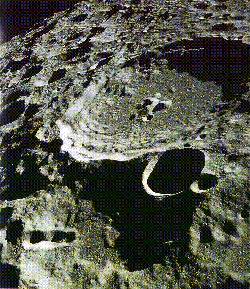 donuts. donuts.
These were actually chunks of moon dirt
that were coated by glass.
The glazed areas are clearly
concentrated toward the top surfaces of protuberances, although
they exist also on some sides. Points and edges appear to be
strongly favored for the glazing process.
In some cases, droplets appear to
have run down an inclined surface for a few millimeters and
congealed there. [1]
Hardly anyone in the general public was
made aware of this discovery and, even if they were, they could
hardly have realized the significance.
But in 1969, an article in Science by T. Gold [2]
proposed a theory of how they were made. Glass, as we know, is made
from melting sand. It occurs naturally near sources of high
temperature, such as volcanoes and meteor impacts.
The atom bomb
tests in New Mexico's White Sands area produced a small "lake" of
glass at ground zero. So it was never a question about the lunar
glass also having been created by something very hot.
The fact that the glaze was confined to small patches, 0.5 to 10mm,
suggested to scientists that the surface had been zapped rather than
slow-cooked. And the likely source of this zap was our Sun. Gold
estimated that the solar luminosity would have had to increase by
100 times what it is normally, for a duration of from 10 to 100
seconds.
Also, because of the lack of debris or dirt covering this glass, it
must have occurred within the last 30,000 years. This made Gold
propose that the Sun - our Sun - does this every 10,000 years or
more. He suggested that future research should look for a "trigger"
event - possibly a large comet or asteroid impacting the surface of
the Sun. He estimated this would only have to be 100 km and weigh 3
x 1021 grams.
Decades passed and this theory didn't receive much attention. Then,
as it often does, the theory got a fresh look by a genius, Dr.
Paul LaViolette (below image.) He was not
satisfied with the source of the glass being caused by a solar
blast, mainly because the output would have had to be on the scale
of a nova, not just a flare.
He envisioned another possibility.

LaViolette envisioned a large solar
flare or coronal mass ejection (CME) that would become magnetically
entrapped in the Earth's magnetosphere [2].
The magnetosphere would then hold on to
this fireball of radiation like a magnetic thermos bottle, allowing
the Moon and Earth to be exposed for a duration of time long enough
to really "flash bake" their surfaces.
Critics quickly denounced LaViolette's theory citing evidence of
"cosmic dust" and rare elements in the lunar glass and concluding
that the heat source was from a meteor impact. [3]
But LaViolette proposed that this cosmic dust was likely present on
the surface of the Moon during the time it was melted into the
glass. In fact, he proposed that the entire solar system was full of
this cosmic dust at the time of this solar eruption. He was
vindicated when polar ice cores showed unusual cosmic dust deposits
at strata marking the end of the last ice age [4].
This time period, about 12,950 BCE,
approximates the current age of the Moon glass.
So where did all this cosmic dust come
from?
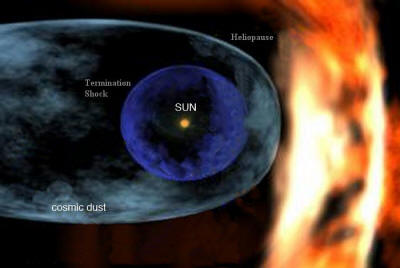
Like Earth, our entire solar system has
its own atmosphere, called the heliopause.
This "bubble" surrounds the Sun and
planets as it travels through galactic space. Like our earth's
magnetosphere, the movement of the heliopause creates a rounded
"head" and a narrowing "tail." Actually, it's more egg shaped (see
above). Until recently, astronomers believed that our solar system
was a region relatively free from cosmic dust. The cosmic dust and
frozen material of space were kept outside this protective bubble.
This was confirmed when the IRAS and Ulysses spacecrafts showed
infrared images of the solar system, surrounded by wispy clouds of
cosmic dust that increase in density just beyond Saturn.
So if the cosmic dust is surrounding the heliopause, what would make
it suddenly enter the heliopause and how would this coincide with
huge solar flares?
LaViolette envisioned something disrupting the
heliopause from the outside, impacting it and drawing cosmic dust
inside with it and energizing the Sun. The energy of such an impact
would be immense.
The most logical place to look for such
enormous energy was the Milky Way Galaxy.
The smoking
gun
Examining the shape of the cosmic dust clouds, the
IRAS satellite
team reported that the cloud was tilted relative to the solar
system's ecliptic - the narrow plane containing our planets.
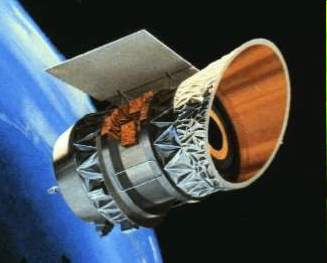
LaViolette realized that this odd
alignment tracked back to the Galactic center.
This was quickly
verified by NASA's
Ulysses spacecraft and New Zealand's
AMOR space
radar observatory. Whatever caused the last ice age to end, the Sun
to flare up and caused the glass to form on the Moon, came from the
center of the Milky Way Galaxy.
The plot was getting more interesting.
Astronomers have known about intense radiation from space since the
1970s.
Multiple bursts of powerful gamma rays
were routinely detected and believed to originate from stars in the
Milky Way. Assuming this energy originated locally, astronomers
concluded this type of gamma ray burst was insignificant and
harmless. Then, in December 1997, they had the technology and good
luck to catch a strong gamma ray burst and track it. The source was
not inside the Milky Way Galaxy.
It was from a distant galaxy billions of
light years away.
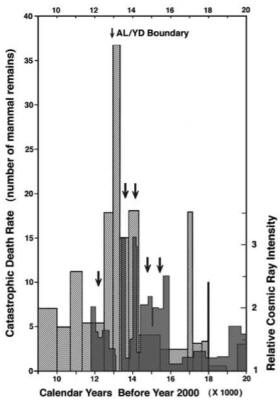
A review of other bursts showed that
their assumptions had been wrong.
All of the gamma ray bursts they were
observing were from other galaxies far, far away. The amount of
energy coming from objects so distant was a real shock. No one had
ever imagined such powerful bursts could be generated by galactic
centers. The thought of a burst coming from our own Milky Way
galactic center was abysmal. A burst of the same intensity as the
1997 event, originating from inside the Milky Way, would deliver
100,000 time the lethal dose of radiation, killing every life form
that was exposed.
Could that really happen to us?
This question was answered on August
27th, 1998 when an unusual 5 minute gamma ray pulse was located just
20,000 light years away in the
constellation of Aquila. This may
sound like a huge distance, but to astronomers this is just "next
door." The Milky Way Galaxy, for example, is just 100,000 light
years from end to end.
The 1998 event was close enough and strong enough to ionize Earth's
upper atmosphere, damage a couple of spacecraft and disrupt global
communication. Since then astronomers place gamma ray bursts from
the Galaxy's core at the top of the list of things we don't want to
happen.
Before Aquila, scientists just feared exploding stars - novas and
supernovas. Now things are different. It's like living in a ghetto
and fearing drive-by shootings and random bullets.
Then one day you learn that there's a
nuclear bomb down the street, waiting to explode.
Not in my
galaxy!
Ironically, all of these facts are incorporated in
LaViolette's "superwave" theory.
He concludes that there are cyclical and
frequent explosions from the Galaxy's core. These waves of radiation
advance outward to the edges of the Galaxy, impacting everything and
causing stars to erupt in their path. He believes this is what has
happened many times to our own solar system - the most recent
superwave of radiation being 14,950 years ago.
He envisions the shock wave - or
superwave - dragging cosmic dust along with it as it enters the
heliopause and energizes our Sun.

Ice core samples support this view.
Evidence of the effects from cosmic dust
show at ice core strata corresponding to the years 11,880 to 11,785
BCE.*
* These
dates have been updated following more precise research from Dr.
LaViolette.
This evidence, along with the Moon
glass, the presence of cosmic dust and the abrupt and atypical end
of the last ice age - all point to an intimate relationship between
extreme solar activity and gamma radiation from the Milky Way
Galaxy's center.
Something has
changed
More troubling is the suggestion by some scientists that this
powerful radiation may not require a dramatic burst or explosion to
cause eruptions in the Sun.
Physicists at nearly a dozen research
institutions, including New York University, have discovered
evidence for very high energy gamma rays emitting from a narrow band
at the equator of the Milky Way.
These gamma ray levels mark the highest
energies ever detected from the Galaxy.
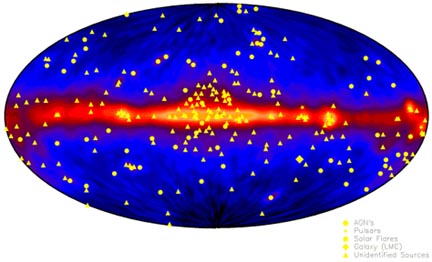
The gamma rays had a median energy of
3.5 trillion electron-volts, or 3500 times the mass-energy of a
proton. Previous satellite experiments have seen gamma-ray emissions
along the galactic equator reaching up to energies of only 30
billion electron-volts.
Perhaps related to this is the puzzling fact that, even though we
have witnessed no Galactic explosions or "bursts", the measurements
of cosmic dust streaming inside the heliopause as been steadily
increasing [6] to almost three times since the last solar
maximum in 2001.
During the solar maximum of each 11 year cycle, the polarity of the
Sun shifts - North becomes South and visa versa. This brief period
of magnetic instability allows some cosmic dust to enter the
heliopause because the Sun's "shields" are reduced. But once the new
polarity is established, the Sun usually quickly blocks the dust.
This time it didn't happen. Cosmic dust has been streaming in from
the Galactic center and astronomers are at loss to explain why.
It's likely that the solar system is already experiencing the
invasive energy from the Galactic equator as we move into position
and align with it on 2012.
Yes, there's
more!
What will it be like when this happens to us?
Perhaps the most dramatic evidence of
what we can expect in 2012 comes from the most unlikely place -
ancient petroglyphs! Ancient rock carvings from around the globe,
created during the last solar "zap" 14,950 years ago, seem to
illustrate a spectacular event that happened when the Earth was last
hit by extremely high radiation.
This is a little difficult to explain,
but I'll try.
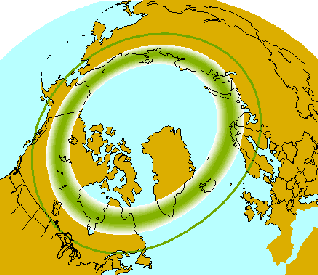 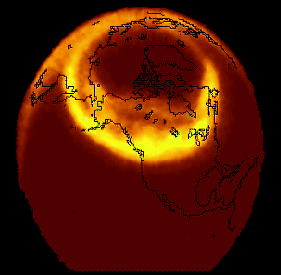
Viewed from the top,
the aurora actually
forms a luminous and electrically charged cup (or chalice)
shape extending into
space from each pole.
We are all familiar with the sparks that
flash brightly when we discharge electrical current.
Lightening is a good example. Extremely
high energy, called plasma, has been shown to form unique shapes
when it is made to discharge - especially around a sphere. The
northern lights are an example of how this "spark" of plasma can
form luminous, electrically charged sheets or tubes at the Earth's
poles.
The
aurora, as it is called, occurs when mild energy from our
Sun is trapped and dissipated by the Earth's magnetic poles.
Extremely high energy - the type that would have caused the Moon
glass and zapped the Earth - creates a more elaborate discharge.
Physicists call it a
z-pinch formation. The z-pinch has been
extensively researched by a group headed by Anthony L. Peratt
with the Los Alamos National Laboratory, Los Alamos, NM and is
described in his paper, Characteristics for the Occurrence of a
High-Current Z-Pinch Aurora as Recorded in Antiquity Part II:
Directionality and Source [5].
In this paper, Dr. Peratt illustrates
the shape and characteristics of this high energy discharge on the
Earth and shows thousands of petroglyph sites all over the globe
where this z-pinch was observed and recorded in ancient carvings.
The term z-pinch originates from experiments where physicists made
extremely high current to flow through thin wires that were arranged
vertically in a tubular formation. They noticed that the energy
quickly vaporized the wires, but the magnetic field generated by
these paths remained and contained (or "pinched") the stream of
energy, collapsing the streams of energy toward the center of the
tube-like configuration - called the z-axis.
When the streams of energy converge,
they form unique shapes that persist and can be observed as
Birkeland elements, named for their discoverer.

Above (left): Virtual
image of the intense auroral plasma column as viewed at an angle of
inclination, not to scale.
Above (right):
Conceptual view of the Birkeland sheath filaments surrounding Earth
(28 close pairs).
The relativistic
electron flow is downwards toward Antarctica.
The current bundle
above Antarctica twists in counter-clockwise rotation.
By convention, the
Birkeland currents and ion flow is upwards toward the Arctic.
Not yet completely
resolved is a bend in the upper filament sheath
that allows the upper
plasmoids and column to be seen at northern latitudes.
If the Earth was zapped by high energy radiation, either from the
Sun or the
Galactic core, the planet would be surrounded with
distinct lines of energy, converging at the North and South pole.
These bands would continue to extend
well out from the planet's poles and into space and would be visible
from almost every point on Earth - each with its own unique
perspective.

Laboratory experiments with a metal
sphere, representing Earth, show the "chalice" shape created by high
energy paths [above]. Oddly, repeated experiments show a preference
for 56 "rays" or distinct bands of energy.
This same number is often depicted in
the ancient petroglyphs!

Above (left):
Northern hemisphere petroglyphs from the Columbia River Basin,
45.65ºN, 121.95ºW.
Center: Oblique view
into the auroral plasma column from these coordinates.
Above (right):
Nasca,
Peru vase, date unknown (14.24ºS, 75.58ºW).
Note the similarity
to the northern hemisphere petroglyphs.
Recent global archiving of global petroglyphs have demonstrated that
these shapes were correctly recorded in rock carvings by humans who
witnessed this event!
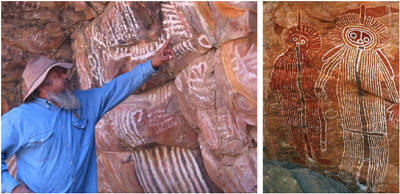
Above (left):
White-striped pictographs at Iga Warta Cultural Tourism Centre,
North Flinders Range (30.59ºS, 138.94ºE).
Shown is Cliff
Coulthard, Australian Department of Environment and Planning in
Aboriginal Heritage,
an authority on
pictograph painting techniques having analyzed such works as the
Magdalenian cave art in France.
Above (right):
Lightning Brothers, Ingaladdi, Victoria River, Wardaman country of
the Northern Territory (15ºS, 130ºE).
New dating techniques
of this red inorganic-pigmented pictograph image
were done using a
plasma-chemical extraction method and correspond to the era of
the
z-pinch.
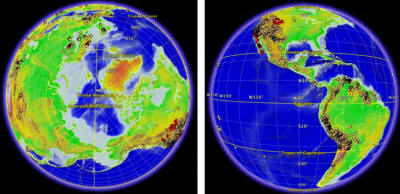
When researchers went to various
petroglyph sites that contained the z-pinch artifacts they carefully
plotted the GPS location and noted if the ancient artist had a clear
view of the Southern horizon. Almost all of the sites had this view.
The number and extent of these global
petroglyph sites clearly demonstrate the purpose of this art.
Also,
depending on the latitude, depictions of the z-pinch corresponded to
the exact perspective that would have been expected.
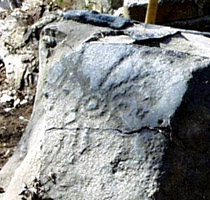 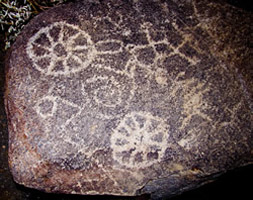 
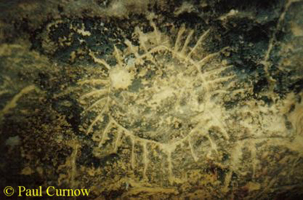 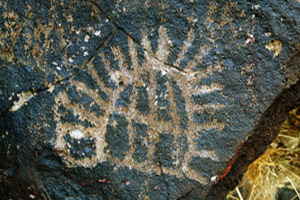
Some examples of z-pinch petroglyphs are
shown here. We highly recommend reading the complete article.
We especially thank team member, John
McGovern, for bringing this important work to our attention.
So what do we
know for sure?
The recent data shows that dramatic and potentially deadly effects
can result from
solar flares and coronal mass ejections.
Substantial data suggests that an event,
similar to the one anticipated in the 2012 "doomsday" scenario,
occurred about 14,950 years ago and was recorded by ancient humans.
This event appears to have lasted for several years in duration and
was responsible for the abrupt end of the last ice age as well as a
substantial culling of the human population.
The surprising findings of LaViolette, supported by other research,
suggests that the extreme solar event corresponded to powerful
radiation coming from the center of the Milky Way Galaxy and was
associated with gamma rays and cosmic dust.
Recent observations have shown a
dramatic increase in gamma ray energy in the Galaxy's equator which
will be in maximum alignment with our solar system on December 12,
2012. The past records in ice cores (strata from 13,880 to 13,785
BCE) suggest that intense radiation from this last event could have
lasted many years.
It seems highly likely that this
alignment will cause another extreme solar event since other factors
precipitating a "solar maximum" (i.e. the opposition of major
planetary barycenters) also converge on this exact date.
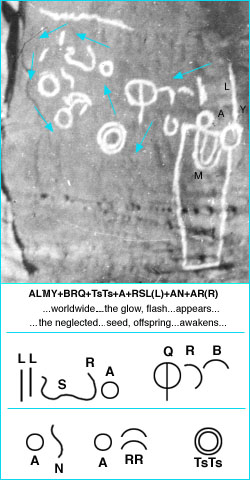
The fact that galactic centers routinely
radiate lethal gamma rays makes it unlikely that life, at least as
we understand it, can survive in the universe. Sooner or later it is
destined to be zapped.
A new genetic study of Y-chromosome variation by Dr. Marcus Feldman
of Stanford University shows that the population from which the
world's present population is derived consisted of about 2,000
individuals. Somehow, humans, flora and fauna did survive the past
doomsday and some may yet survive past 2012.
Indeed, many of the
ancient prophecies I have encountered in my travels around the world
have spoken of a "bright light" or "flash" followed by the "good
seed" (i.e. humanity) which would rise up and repopulate the world.[7]
Organisms on Earth, including humans, have evolved during quiet
times - between the lethal blasts from our own Milky Way center.
This means that we are indeed quite unique (and lucky). But it also
means that our ultimate demise is part of the natural order. This
universe is larger than ourselves and our lives. We are just
transient phenomena, seemingly running counter to the laws of
entropy, yet a part of the cosmic reality. This is neither good or
bad. It simply is.
And yet there is part of us that may continue.
This hope is what we must hold on to.
References
[1] Gold, T. "Apollo II Observations
of a Remarkable Glazing Phenomenon on the Lunar Surface."
Science 165 (1969):1345.
[2] Excerpt from Paul LaViolette's 1983 Ph.D. dissertation,
"Galactic Explosions, Cosmic Dust Invasions, and Climate
Change."
[3] Morgan, Laul, Ganapathy, and Anders (1971 Morgan, J. W.,
Laul, J. C., Ganapathy, R., and Anders, E. "Glazed Lunar Rocks:
Origin by Impact." Science 172(1971):556
[4] Zook, H. A., Hartung, J. B., and Storzer, D. "Solar Flare
Activity: Evidence for Large Scale Changes in the Past." Icarus
32(1977):106
[5] Anthony L. Peratt, Fellow, IEEE, John McGovern, Alfred H.
Qoyawayma, Life Member, IEEE, Marinus Anthony Van der Sluijs,
and Mathias G. Peratt, Member, IEEE, "Characteristics for the
Occurrence of a High-Current Z-Pinch Aurora as Recorded in
Antiquity Part II: Directionality and Source," IEEE Transactions
on Plasma Science, Vol. 35, NO. 4, August 2007.
[6] Markus Landgraf, Max Plank Institute.
[7] www.viewzone.com/comanche2.html -also- www.viewzone.com/firsttongue.yemen.html
-also- www.viewzone.com/oklahoma11.html
|




 It's
all about the Sun
It's
all about the Sun









 Could
this be a haven for surviving a solar blast?
Could
this be a haven for surviving a solar blast?  donuts.
donuts.


















